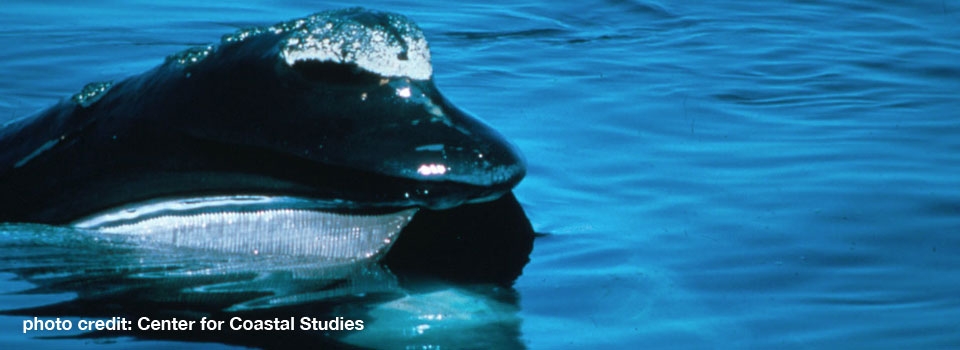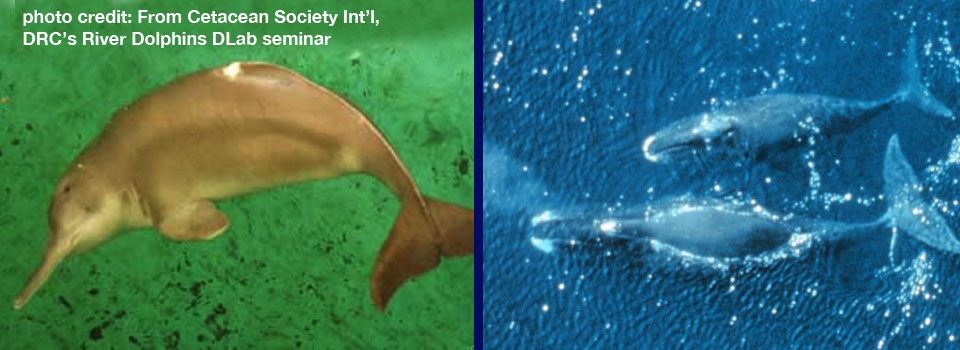- RESEARCH
- LEARN
- Child Education »
- Teen Education »
- Adult Education »
- Resources »
- Endangered Species »
- Kids Zone »
- SHOP

- Providing Sanctuary and a Forever Home since 1984.
- A not-for-profit 501(c)3 marine mammal education and research facility for more than 35 years.
- Providing Sanctuary and a Forever Home since 1984.
A not-for-profit 501(c)3 marine mammal education and research facility for more than 35 years.
Overview
Overview
As a result of whaling and other human and natural influences, sixteen species of whales and dolphins are considered to be in danger of extinction according to the Endangered Species Act. Furthermore, because our knowledge about most dolphins and whales is lacking, there may be many more endangered species. Two species of river dolphins, along with the vaquita porpoise, and the northern right whale are currently included among the endangered species of whales and dolphins.
River Dolphins
River Dolphins
River dolphins inhabit primarily fresh water rivers in Asia and South America. They have adapted quite well to the muddy river environment. They can navigate their way through the silty waters using a highly developed sense of echolocation. Each species of river dolphin is uniquely adapted to its environment. Amazon river dolphins have large pectoral fins, which they use to propel themselves through flooded forests and river shallows. Their cervical vertebrae are unfused, giving them the flexibility to maneuver in tight spots. Indus susus, an Asian species, are nearly blind and rely almost entirely on echolocation for navigating and feeding. They have huge paddle-like pectoral fins used to scoop mud on the river bottom as they forage. These unusual dolphins are also called “side-swimming dolphins because they constantly swim on their sides. Of the five species of river dolphins two, the baiji and the Indus river dolphin, are in grave danger of extinction.
The baiji, which resides in the Yangtze River in China, one of the most industrialized and polluted rivers in the world, is the most critically endangered cetacean. Scientists are concerned that they may already be extinct. A 2006 survey did not spot any baiji, and there have been no confirmed sightings or strandings since the survey. Everything from pollution to fishing, hunting, and habitat destruction threatened the baiji’s survival. Researchers know almost nothing about the biology of this animal and had a difficult time breeding them in captivity. Even if they could successfully breed baiji in human care, researchers would have no natural environment to return them to.
The Indus River dolphin is also endangered. Indus and Ganges River dolphins were recently determined to be the same species. They inhabit the Indus and Ganges Rivers in India and are also known as the Susu or Bhulan. Dams and barrages that have been constructed to provide hydroelectric power have separated populations into completely separate stocks and threatened their survival. Like the baiji, the Indus River dolphin is affected by other human influences. Again, researchers know very little about the natural history of this animal, and as a result have had difficulty establishing any successful recovery plans.
Vaquita
Vaquita
The vaquita porpoise is critically endangered. The vaquita is the smallest cetacean in the world, and has one of the smallest habitats of any cetacean. It lives in the upper-most portion of the Sea of Cortez in the Gulf of California between Mexico and Baja. For both of these reasons, and because the vaquita is extremely elusive, few researchers have observed the vaquita in the wild. The vaquita was only discovered in the past fifty years when carcasses began to wash up entangled in fishing nets. Since then, we have learned little about the natural history of these shy animals.
Unfortunately, the world may never know much about the vaquita because its numbers are quickly diminishing. In the past, gill nets used by totoaba (a large sea bass) and shark fisherman killed large numbers of these animals. Even though these fisheries have declined in recent years, other nets as well as trawlers remain a threat to the vaquita along with pollution and habitat destruction.
Northern Right Whale
Northern Right Whale
The Northern right whale is the most endangered large whale in the world. It resides in the North Atlantic, along the east coast of the United States and Canada, and its population is estimated to be about 400 animals.
Commercial whaling severely depleted right whale populations to virtual commercial extinction by the end of the nineteenth century. People continued to take right whales, however, and in 1935 an international treaty adopted a voluntary ban on hunting because the right whales were on the brink of biological extinction. Unfortunately, whaling of right whales continued until the 1960’s. Currently, whaling is no longer a threat to the right whale, but because their numbers are so small, other human-related impacts threaten the population, namely collisions with ships and entanglement in nets.
The Western North Atlantic is the only population of right whales for which we have enough data on their distribution, demography, and human interactions to develop measures of protection. Over the past twenty years, the average number of calves born was fewer than twelve, and the reproduction rate is on the decline. Any form of protection for the right whales is crucial because even a small number of deaths will affect the population.
Since 1970, nearly half of confirmed right whale deaths have been attributed to human factors, and most of those deaths have been a result of ship collisions and entanglement. In 1991, NOAA Fisheries developed a right whale recovery plan that divided the east coast of the United Stated into two halves, Northeast and Southeast. The plan for the Southeast coast established protection for right whale calving grounds. The Northeast program was coordinated with humpback whale recovery, and protects feeding grounds in New England. Focus has been centered on reducing the number of ship collisions.
Reducing the number of ship collisions has proved to be difficult because collisions are rare and mariners do not perceive themselves or the whales as a threat. Whales are also difficult to spot in time to change the course of a ship and collisions are usually unintentional. As a result, protection measures have focused on changing operating procedures for vessels that frequent right whale habitat, forming early warning systems, distributing educational material for mariners about right whales, instituting mandatory right whale reporting for ships in key habitats and conducting research to learn more.
Commercial fishing is still considered a major threat to right whales. NOAA Fisheries reports that studies suggest that more than 85% of right whales have been photographed with scars from fishing gear. In order to address these issues, NOAA Fisheries developed the Atlantic Large Whale Take Reduction Team in 1996. They are focusing on fishing restrictions in key habitats, fishing gear that would be less likely to entangle whales, and detection of entangled whales.
Unfortunately, funding for right whale protection has been insufficient. As a result, a National Whale Conservation Fund Act was established in 1998. Now, right whale conservation programs can make money from logos and accept donations from the public.
Bowhead Whales
Bowhead Whales
Commercial whaling severely depleted bowhead whale stocks in the early 1900’s. Since the mid-1960’s, the International Whaling Commission has classified bowhead whales as protected and in the 1970’s bowhead whales were added to the Endangered Species List. Bowhead whales live exclusively in Arctic and sub-Arctic waters. The least exploited stock is in the Bering-Chukchi-Beaufort Seas.
Ten coastal villages in Alaska hunt bowhead whales as a part of their culture, using the whale meat for food. The International Whaling Commission (IWC) has established an aboriginal whaling regime with recommended quotas. The IWC contends that bowhead stocks in the Bering-Chukchi-Beaufort Seas can sustain their population numbers even with the aboriginal takes. They estimate that hunters could kill up to 108 animals per year before they would begin to deplete stocks. Even so, hunters have recovered six harpoon points from individual bowhead whales that have not been used for over 100 years. This may mean that bowheads can live 100 years or more, or it can mean that some hunters have been using old spearheads. In either case, researchers do not know very much about the life history of these whales. As a result, it is difficult to say for sure whether any amount of whaling may have a negative impact on bowhead whale stocks. Additionally, natives in Canada also hunt bowhead whales, but without the approval of the IWC. They have taken whales from the Bering-Chukchi-Beaufort Seas stocks, as well as stocks in eastern Canada that are even more highly endangered.
The Endangered Species Act still lists bowhead whales as Endangered, but the IUCN lists them as Least Concern as their numbers have risen in recent years thanks to better conservation efforts.
How To Help
How to Help
To ensure the survival of endangered marine mammals a concerned, active, public interest must exist. Stay informed by maintaining contact with some of the organizations working to save endangered species. A few reputable contacts include:
International Union for the Conservation of Nature
1630 Connecticut Ave. NW
3rd Floor
Washington DC (DC)
Phone: (202) 387-4826
Fax: (202) 387-4823
E-mail: postmaster@iucnus.org
www.iucn.org
World Wildlife Fund
WWF Global Appeal
1196 Gland
Switzerland
Fax: +41 22 364 0074
www.wwf.org
The Ocean Conservancy
1725 DeSales St., NW, Suite 500
Washington D.C. 20036
Phone: (202) 429-5609
Fax: (202) 872-0619
www.oceanconservancy.org
Our Mission -
Through education, research and rescue, Dolphin Research Center promotes peaceful coexistence,
cooperation and communication between marine mammals, humans and the environment we share with
the well being of DRC's animals taking precedence.












